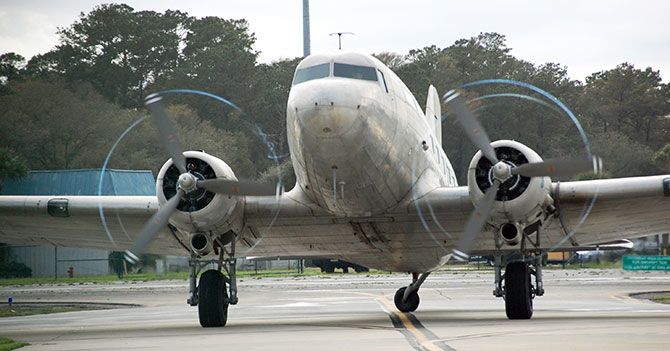Rajya Sabha MP Rajeev Chandrasekhar is underwriting the revival of a vintage Dakota as a gift to the Indian Air Force.
Veenu Sandhu reports on this challenging personal project to preserve a significant piece of military history.

Coventry Airfield in the United Kingdom is several thousand miles away from the Indian Air Force base of Mohanbari in Assam. Not for Rajeev Chandrasekhar.
For the past few years, this Midlands air base, which was once a storied fighter station during World War II, has been host to a genially eccentric project by the Rajya Sabha MP to revive a vintage Douglas DC3 aircraft, better known as the Dakota, the workhorse that first saw action in the 1930s.
Chandrasekhar bought the aircraft from Ireland in 2010 with the intention of making it airworthy and gifting it to the IAF -- "free of cost, no strings attached" -- for its fleet of vintage aircraft.
For him, the Coventry airfield revives memories of his father M K Chandrasekhar who commanded a Dakota squadron. He remembers often standing on the periphery of the Mohanbari runway, watching his father climb into a Dakota in his overalls and take off.
Even today, he says, that childhood image makes him nostalgic and brings a sense of pride that he finds lacking in our own culture of preserving military history.
When the aircraft arrived at the Coventry Airfield, Chandrasekhar realised the magnitude of the challenge that lay ahead. "It wasn't something that would make you jump up and down with joy. It was in pretty bad shape," he recalls.
Today, the same Dakota also stands with a sense of pride, painted in old colours of the IAF. Both its engines, which were beyond salvation, have been refabricated and fired up a few times. Chandrasekhar was present at the Coventry Airfield to witness the feat the first time the engines roared to life.
It might not be long now before the iconic military transport aircraft, one of the hardiest airplanes ever manufactured, flies out of the English village and makes its way to India.
The defence ministry has agreed to Chandrasekhar's request to gift the Dakota, with the rider that the aircraft be formally handed over in India. It is for Chandrasekhar to ferry the plane from England to here.
Then defence minister A K Antony had turned down the proposal saying that there was no precedent of accepting a vintage aircraft for the IAF as a gift.
IAF's vintage squad currently has only one Tiger Moth, a World War I plane, and a Harvard capable of flying. All others are used just for display on the ground.
Chandrasekhar's quest for the Dakota started about seven years ago when, he says, a "shocking fact" became obvious to him. "There was not one airworthy aircraft from the 60, 65 years of post-Independence history of the IAF or indeed the 100 years of the history of the Royal Indian Air Force," he says.
When he started looking around for Dakotas in India that could be restored, he was presented with another horrifying fact: The last of the Dakotas, which was parked at the air force station in Sulur near Coimbatore, had been sold as scrap.
"The air force did not have the budget to maintain it and the political leadership did not have the sense of history to salvage it," he says.
So he broadened his search, to Europe and the US. A chance meeting with a British Airways pilot with a fascination for old aircraft and India's military aviation history led him to an aviation hobbyist in Ireland who had a handful of Dakotas for sale.
"This one was among the cheapest, but also required most restoration. It was grounded but the people I consulted believed that it could be made airworthy," says Chandrasekhar.
For the engineers of Reflight Airworks, who are restoring the aircraft, this has been a daunting task, but not an impossible one. "This current DC3 has been completely gutted inside giving a blank canvas form with which to start," says Alex Woodeson, engineering head of Reflight Airworks.
To restore the interior, engineers will put in place a new seating arrangement in the rear fuselage (the aircraft's main body that holds crew and passengers or cargo). A new paint scheme has also been completed.
The biggest challenge in the restoration of a vintage aircraft, however, is finding its original spare parts. The DC3 had stopped production back in 1942. So going back to the company was not an option.
"But there is a vast network of aviation enthusiasts spread across Europe and the US. And these hobbyists openly exchange information and spare parts, sometimes as barter and at other times for a price," says Chandrasekhar.
For example, one guy might have the wheels, another might have the undercarriage and yet another might have some parts needed in the cockpit. This is the ecosystem Chandrasekhar says they plugged into.
One Dakota restorer, for example, has put out his wishlist -- co-pilot's junction box, hydraulic fluid reservoir, standby compass bungee set and so on -- on his website in the hope that another restorer who has these parts to spare will reach out to him.
In the event that a particular part is not available, the engineers fabricate it from the original drawings. If they don't have the drawing on them, some other hobbyist or the company (Douglas Aircraft is now part of Boeing) might, just like they might have the spare parts. That is how Woodeson and his team rebuilt the engines of this particular Dakota from scratch.
The ground up restoration of the aircraft to its original flying conditions using original engine, power and flying characteristics also requires extensive refurbishment and equalisation checks, explains Woodeson. "This is a very time-consuming job as every system and component must be satisfactory."
Besides, all DC3 aircraft are different in terms of their layouts and upgrades, he adds. You are never exactly sure what you are going to find once you start stripping all the components and airframe apart for inspection, says the engineer. "Some parts will have been on the aircraft since 1940 and not have been overhauled or inspected to this level of detail."
Besides the interior, parts of the aircraft's navigation system are also being upgraded and a parachute door is being introduced for use in India. In its days of glory, the Dakota was routinely used for air-dropping supplies and paratroopers to areas that would otherwise be inaccessible.
Woodeson expects that the Dakota would have taken over two years to restore before it arrives in India. But before it is allowed to truly take to the skies, "every component of it will have to be certified by European authorities for airworthiness," says Sharad Yeshwant Savur, who retired as air marshal and extensively flew the Dakota during his career.
"The time it takes for the engine to start, the way it taxis on the runway, the brake functioning, the way the nose of the aircraft goes up -- all of it will have to meet the characteristics of the original aircraft for certification," says Air Marshal Savur.
It is a painstaking process that calls for both passion and patience. Chandrasekhar won't reveal the cost of restoring the aircraft though.
And while he has a commercial pilot's licence, he has not flown in the Dakota he is getting restored. "The UK is very clear about certification of a hobby aircraft," he says. "Only the captain and co-pilot can use it for hobby flying. They cannot ferry passengers in it," he says.
Fali Homi Major, who retired as chief of the air staff, is delighted that an airworthy Dakota will finally make its way to the IAF vintage fleet. "It was the finest aircraft ever designed and the most rugged. It has operated from every airfield," he says. "You could fly it in the day, at night or in hostile mountainous areas. You could land it on short runways as well as on grass or dirt airstrips."
When he was asked to list the weapons that most helped end World War II, this is what wartime general and later US president Dwight D Eisenhower had replied: The bazooka, the Jeep, the atomic bomb and the Dakota.
If the Dakota played a critical role in the victory against Adolf Hitler, it did so again during the Kashmir operations of 1947-1948, audaciously flying in troops and flying out the wounded against heavy shelling by the infiltrators who had come prepared to pluck Kashmir away from India.
"The Dakota is the reason why Poonch is still with us," says Pushpindar Singh, military historian and author of Aircraft of the Indian Air Force: 1933-73.
Veteran fliers speak of the iconic aircraft with unmistakable wistfulness. "Given a chance, I would fly the Dakota again," says Air Marshal Savur. He calls it "the most forgiving aircraft in the world."
'With its 500,000 rivets, the DC3 might be thought to be over-engineered, but it had the reputation of being virtually indestructible,' wrote The Economist in the obituary of aeronautical engineer Arthur Raymond who led the team that designed the Dakota.
Pilots would laughingly describe it as 'a collection of parts flying in loose formation' but they would also say that 'the only replacement for a DC3 is another DC3.'
The predecessor of the DC3 was the DC2, not as hardy or as successful. Singh recounts a World War II incident when a Dakota landed in a jungle.
"A quarter of one of its wings got shorn off. It obviously could not take off," he says. "So the pilot and the crew decided to cut off a quarter of the other wing as well." And, lo and behold, the plane flew home -- "they named it the DC2-and-a-half," chuckles Singh.
The aircraft was also used extensively for commercial flying. Biju Patnaik's Kalinga Airlines operated a dozen Dakotas. Jamair, a Kolkata-based privately owned non-scheduled charter airline that was financially backed by the Nawanagar Maharajah Jam Singh had a fleet of five Douglas DC3s and three DC4s.
In fact, by 1939, the DC3, which is credited with making air travel popular, accounted for 90 per cent of world airline trade.
Once restored, the Dakota at the Coventry Airfield, meanwhile, has another journey ahead of it: From England to India. Chandrasekhar would like the plane to be dismantled, put in a carton, flown to India and reassembled here.
"It is an old aircraft and several countries have issues about an old aircraft flying over their airspace," he says. "Besides, flying it all the way from the UK, especially over conflict zones in West Asia, would not be safe."
Woodeson, however, says this aircraft will have to be flown all the way due to its vast size.
Clearly, another challenge awaits the Dakota.
IMAGE: A DC-3 aircraft. Photograph: Kind courtesy Jud McCranie/Creative Commons












 © 2025
© 2025